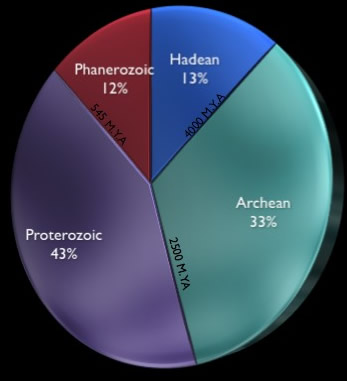Deep Time: Precambrian Earth
 |
Eons of geologic time |
The precambrian, an informal term used to describe both time and rocks, represents 88% of all geologic time. It begins more than 4.6 billion years ago with the birth of Earth and lasts for more than 4 billion years until the begining og the Phanerozoic eon. Precambrian time consist of two formal eons the earliest of which is the Archean and the later being the Proterozoic.
Due to plate tectonic processes none of the rocks produced for the first 600 million years of Earth's history are still present on ; as a result our geologic record actually begins about 4.0 billion years ago with the oldest known rocks on Earth except for meteorites. The same processes that lead to the destruction of Earth's oldest rocks also make deciphering the geologic record we do have for the Precambrian much more difficult due to the complexity with which they have been deformed and due to metamorphic processes which have altered them over time. Adding to these difficulties is the fact that many precambrian rocks have been deeply buried and therefore innaccessible and they contain few fossils of any use in biostratigraphy. None the less, the geologic evidence that we do have is of great use when determining major events that have occured on Earth over time.
The Hadean: The birth of Earth
Earth's oldest known body of rocks is the Acasta Gneiss in Canada, and it dates to about 4.0 billion years ago. This means that we have no geologic record of the first 600 million years of Earth's history. However even with no earlier geologic record we can still make some assumptions about the early Earth based on what we do have. As discussed in the chapter on geologic time, absolute dates of metamorphic rocks actually record the age of metamorphism so, if our earliest known rocks metamorphosed 4.0 billion years ago there must have been some sort of crust already present on Earth prior to that age--detrital sediments in Austrailia containing the mineral zircon (ZrSiO4) have been dated to 4.4 billion year indicating that source rocks were present on the surface by 4.4 billion years ago.
| Video clip explaining the formation of the Moon |
The solar nebular theory tells us that like all other terrestrial planets, Earth was produced through the gradual accumulation of material through bombardment by meteorites. Our current understanding of this process leads us to also believe that Earth was probably hit by a Mars-sized planetesimal between 4.4 and 4.6 billion years ago. The ejecta from this enormous collision eventually coalesced in orbit and formed the Moon.
Early Earth most likely retained much of the residual heat caused by accretion in the early solar nebular. Radioactive isotopes were also more abundant than today and, as a result, more heat was generated internally as a result of radioactive decay. Earth was therefore a much hotter planet than it is today and contained sufficient energy to allow some form of tectonic activity to begin. Studies of the Earth-Moon system also tell us that friction caused by the Moon on Earth's oceans and landmasses causes its rate of rotation to slow very slightly every year. This means that when Earth first formed it rotated much faster and one day may have been as little as 10 hours long.
